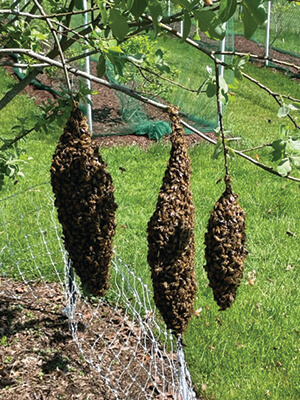Letters to the Editor
Letters to the Editor – July 2022

Triple Swarm
We’ve been beekeepers for 10 years. We had the best mentor, Al Avitabile. I recently send Al this picture of a swarm we had in our yard and he told me to send it to ABJ with the caption, “When three is not a crowd.”
They were easy to catch, like the ones we get on our hammock. We put a hive body in our garden cart with a couple of frames and wheel it close or under the swarm. A quick jolt and they all fell in. I had the branch with the large group and Kate had the other two. On three, they all went inside the box. We wait until everyone settles and then wheel them in our apiary. We’ve gotten about 15 that way in the last couple years. The pussy willow we planted for the bees for the spring blossoms. But they also use it for swarms. That and our hammock.
Susan Gray and Kate Moran
Terryville, Connecticut
Don’t Fight Nature
Being the youngest sibling, I was able to learn many lessons from my brother’s mistakes while growing up. Well … my brother didn’t take up beekeeping. Hopefully you can learn from my mistake.
I’m starting into my fourth year of this hobby. In two separate seasons now, I have encountered a hive that had reached the point in their swarm cycle where they had thinned the queen down in preparation for flight. Both times I attempted to circumvent nature and try to keep the whole colony home when I should have just split them.
The first time I just wasn’t ready for another colony. This was already a split that I didn’t add a second deep hive body to in time. I removed all queen cells, did a 100% shake-out in front of the hive to simulate swarming, and added space to the colony. I came back every other day to remove new queen cells. After 8 days of them building new queen cells, I split them. Then I did a newspaper recombine after a week. After recombining, the queenless half came up and started drawing queen cells on the queenright frames of brood. I gave in, split them and kept them split.
This year I had apparently forgot about my wasted work of two years previous. I did not have frames ready to replace the 5 frames I would have pulled out for a split. I put a queen excluder between the bottom hive body and the bottom board, did a 100% shake-out to simulate a swarm, removed all queen cells, and added a honey super for space. After a week I expected to see the queen fattened back up with eggs in empty frames; no dice. I assumed the skinny mini had squeezed out through the excluder and swarmed while I was at work. I was hoping the colony would hold on long enough for me to graft or find a local queen.
My schedule did not align with the weather for me to do any grafting and I haven’t had a chance to find a local queen. Yesterday was the best weather we have had for probably 2 weeks. I went out to my hives after work with the plan of shaking nurse bees into this queenless hive and making it a cell builder. I decided to do a full 20-frame inspection first to see if I should add any resource frames or reduce to 10 frames. I started seeing multi-egged cells. “I’m too late. They have a laying worker,” I thought.
As I inspected further, I found cells with single eggs in the bottom dead center of the cell. Then I saw her. That white bullseye streaked across a frame with the center of her paint dot chewed off. It was my original queen. It took 3 weeks from the time I took intervention on this colony, but the queen had started laying again. But … now she’s broken. She’s laying multiples and doesn’t have nearly the amount of eggs I would expect from a seasoned queen. I will most likely end up requeening this hive.
In the end, I was left with wasted time and a couple of backward hives. The first time I had two slow-to-grow colonies that only built to single deeps before winter. This year I have a colony that will most likely give me no honey production and is way behind the curve size-wise.
It is possible to obtain a different result than nature would have given you, but not a positive one in the opposite direction. Don’t be like me. Use nature to your advantage instead of fighting against it.
Josh Waters
Montgomery City, MO


